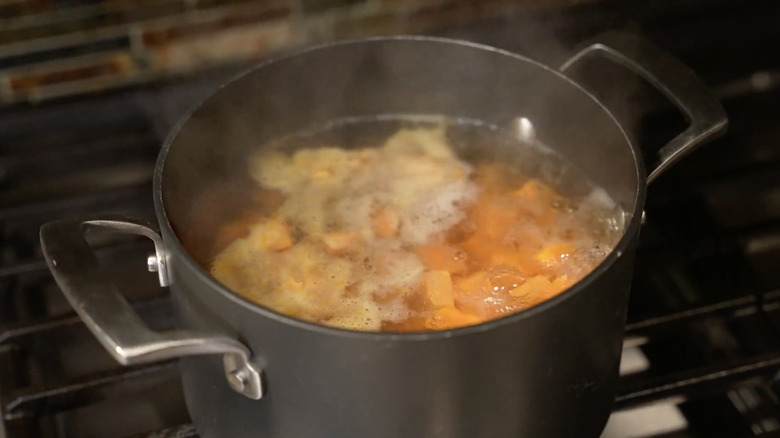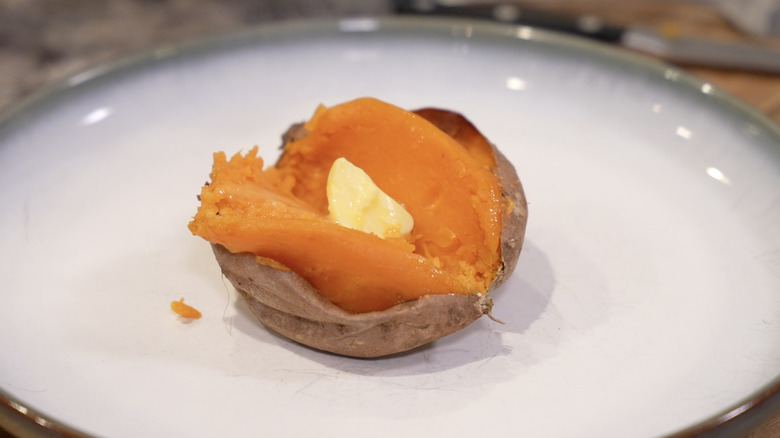How To Cook Sweet Potatoes - You're Doing It All Wrong
Cooking sweet potatoes isn't exactly rocket science: They're delicious whether fried, baked, or roasted, and mastering these cooking methods isn't too challenging. However, there are a few tricks to getting these root vegetables just right.
Before diving into the actual cooking process, it's important to pay attention to a couple of aspects when buying and storing sweet potatoes. While shopping, look out for bruised or otherwise damaged sweet potatoes, including those with cuts in the skin exposing the orange flesh. Although sweet potatoes may appear rugged, they're surprisingly delicate, and damage can cause them to spoil. Small bruises can be cut out, but if those sweet potatoes on the shelf already have larger bruises, they may be partly spoiled and you should leave them behind on your grocery trip.
Once you've brought them home, store the spuds in a cool, dark, and dry place — and definitely don't store your sweet potatoes in the fridge. Storing them in the refrigerator can lead to an unpleasant taste, harden the interior, and cause them to dry out.
What you're doing wrong with sweet potatoes
If you're looking to maximize the earthy yet sweet flavor of sweet potatoes, be aware that not all cooking methods yield equally tasty results. Boiling is one of the lesser methods for cooking them: When you boil sweet potatoes, nutrients and flavor leach out into the water and are lost, as you pour that water down the drain. While boiling is sometimes recommended for dishes that include mashed sweet potatoes like sweet potato pie, you're probably better off roasting or baking them.
Another common mistake is discarding the skin of the sweet potato. Sweet potato skin is edible and nutrient-rich — much of the potassium and fiber is in the skin, so by peeling the sweet potato, you lose these benefits. The skin can also help retain moisture as you cook your sweet potatoes, so even if you plan to discard the skin, it might be wise to cook them unpeeled. Just be sure to thoroughly scrub the outside of the sweet potato before cooking, to remove any dirt.
How to cook sweet potatoes right
Even though boiling sweet potatoes isn't ideal, many other methods work wonderfully with them. If you're especially keen on boiling them (for example, because it allows you to cook them without adding extra fat), opt for steaming them instead. You'll achieve a similar moist texture while keeping more of the nutrients intact.
In general, though, your best options for cooking sweet potatoes are either baking or roasting. For a lovely, crisp exterior, baking is an excellent option — but be sure to bake them whole. If you cut them in half and bake them, the moisture will escape, and you'll end up with more of a steamed sweet potato, especially if they're wrapped in foil when you cook them. If you want to be particularly cautious, you can prick your sweet potatoes with a fork before baking them (to prevent explosions), although there's debate about how necessary this actually is and you should be fine baking the tuber whole in the oven. However, if you're using the microwave — which won't produce the best flavor or texture results but is convenient — you should definitely do this, as the chance of them exploding while cooking is pretty high. For the oven though, place your whole sweet potatoes on a lined baking tray as is. After they've cooked, you can simply pull them out of the oven and top them with butter and salt.
Roasting also produces tasty, crisp sweet potatoes, and is another super simple method. In this case, cut up your potatoes into cubes or slices, toss them in some oil, season, and then pop them on a tray and into the oven. The oil will keep things crispy, but just be careful not to use too much oil: These tubers are quite absorbent, and you could end up with oil-logged, unpalatable pieces of sweet potato.
And there you have it. The best methods for cooking sweet potatoes don't involve a lot of production. Instead, they draw on the natural sugars and moisture in the sweet potatoes to create super simple, but super tasty results.

